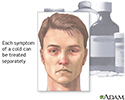Common cold
Upper respiratory infection - viral; Cold
The common cold most often causes a runny nose, nasal congestion, and sneezing. You may also have a sore throat, cough, headache, or other symptoms.
Causes
It is called the common cold for good reason. There are over one billion colds in the United States each year. You and your children will probably have more colds than any other type of illness.
Colds are the most common reason that children miss school and parents miss work. Parents often get colds from their children.
Children can get many colds every year. They usually get them from other children. A cold can spread quickly through schools or daycares.
Colds can occur at any time of the year, but they are most common in the winter or rainy seasons.
A cold virus spreads through tiny, air droplets that are released when the sick person sneezes, coughs, or blows their nose.
You can catch a cold if:
- A person with a cold sneezes, coughs, or blows their nose near you
- You touch your nose, eyes, or mouth after you have touched something contaminated by the virus, such as a toy or doorknob
People are most contagious for the first 2 to 3 days of a cold. A cold is most often not contagious after the first week.
Symptoms
Cold symptoms usually start about 2 or 3 days after you came in contact with the virus, although it could take up to a week. Symptoms mostly affect the nose.
The most common cold symptoms are:
- Nasal congestion
- Runny nose
- Scratchy throat
- Sneezing
Adults and older children with colds generally have a low fever or no fever. Young children often run a fever around 100°F to 102°F (37.7°C to 38.8°C).
Depending on which virus caused your cold, you may also have:
- Cough
- Decreased appetite
- Headache
- Muscle aches
- Postnasal drip
- Sore throat
Treatment
Most colds go away in a few days. Some things you can do to take care of yourself with a cold include:
- Get plenty of rest and drink fluids.
- Over-the-counter (OTC) cold and cough medicines may help ease symptoms in adults and older children. They do not make your cold go away faster, but can help you feel better. These OTC medicines are not recommended for children under age 4.
- Antibiotics should not be used to treat a common cold.
- Many alternative treatments have been tried for colds, such as vitamin C, zinc supplements, and echinacea. Talk to your health care provider before trying any herbs or supplements.
Outlook (Prognosis)
The fluid from your runny nose will become thicker over time. It may turn yellow or green within a few days. This is normal, and not a reason for antibiotics.
Most cold symptoms go away within a week in most cases. If you still feel sick after 7 days, consult with your provider. Your provider may check you for a sinus infection, allergies, or other medical problem.
Possible Complications
Colds are the most common trigger of wheezing in children with asthma.
A cold may also lead to:
When to Contact a Medical Professional
Try treating your cold at home first. Contact your provider if:
- You have problems breathing.
- Your symptoms get worse or do not improve after 7 to 10 days.
Prevention
To lower your chances of getting sick:
- Always wash your hands. Children and adults should wash hands after nose-wiping, diapering, and using the bathroom, and before eating and preparing food.
- Disinfect your environment. Clean commonly touched surfaces (such as sink handles, door knobs, and sleeping mats) with an EPA-approved disinfectant.
- Choose smaller daycare classes for your children.
- Use hand sanitizers that contain at least 60% alcohol to stop the spread of germs.
- Use paper towels instead of sharing cloth towels.
The immune system helps your body fight off infection. Here are ways to support the immune system:
- Avoid secondhand smoke. It is responsible for many health problems, including colds.
- DO NOT use antibiotics if they are not needed.
- Breastfeed infants if possible. Breast milk is known to protect against respiratory tract infections in children, even years after you stop breastfeeding.
- Drink plenty of fluids to help your immune system work properly.
- Eat yogurt that contains "active cultures." These may help prevent colds. Probiotics may help prevent colds in children.
- Get enough sleep.
References
Barrett B. Acute respiratory infection cold and flu. In: Rakel D, Minichiello VJ, eds. Integrative Medicine. 5th ed. Philadelphia, PA: Elsevier; 2023:chap 19.
Barrett B, Turner RB. The common cold. In: Goldman L, Schafer AI, eds. Goldman-Cecil Medicine. 26th ed. Philadelphia, PA: Elsevier; 2020:chap 337.
Centers for Disease Control and Prevention website. Rhinoviruses. About rhinoviruses. www.cdc.gov/rhinoviruses/about/. Updated April 24, 2024. Accessed June 18, 2024.
Lopez SMC, Williams JV. The common cold. In: Kliegman RM, St Geme JW, Blum NJ, Shah SS, Tasker RC, Wilson KM, eds. Nelson Textbook of Pediatrics. 21st ed. Philadelphia, PA: Elsevier;2020:chap 407.
Throat anatomy - illustration
Throat anatomy
illustration
Cold symptoms - illustration
Cold symptoms
illustration
Antibodies - illustration
Antibodies
illustration
Cold remedies - illustration
Cold remedies
illustration
Review Date: 2/2/2023
Reviewed By: Linda J. Vorvick, MD, Clinical Professor, Department of Family Medicine, UW Medicine, School of Medicine, University of Washington, Seattle, WA. Also reviewed by David C. Dugdale, MD, Medical Director, Brenda Conaway, Editorial Director, and the A.D.A.M. Editorial team.

















